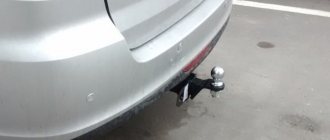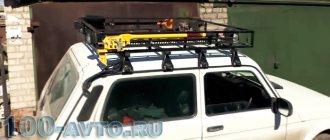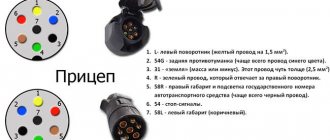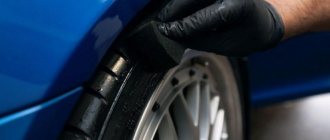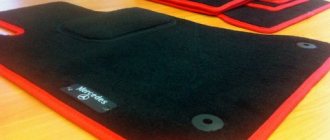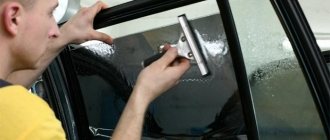Among drivers who travel long distances out of town, the question of how to make a tow hitch for a car with your own hands is a very pressing question. On sale you can find ready-made options for “classics” and new generation cars, but there is a category of car owners who prefer to make them themselves.
For a number of reasons, factory products do not always satisfy demanding users. Sometimes it is not possible to find a successful design, in some cases a person has his own ideas that he wants to bring to life, and some prefer to spend time and effort to avoid unnecessary financial expenses.
On the Internet you can easily find drawings of coupling devices for various brands of cars and instructions on how to weld and assemble the structure. Search forums and specialized websites - and you can choose a stationary, removable or quick-release option for your car model.
Do-it-yourself matching block for a towbar
For owners of modern models equipped with a large number of electronic components and computer control systems, in addition to the device itself, you will need a special smart connector. It is needed so that the vehicle’s electrics do not perceive the connection of the trailer as an emergency and do not use the emergency shutdown.
The towbar is an indispensable device for car enthusiasts who lead an active lifestyle, love to travel, that is, people who often have to transport large luggage
The fact is that a towbar is not just a hook or a rear step, it is a device that, in addition to the direct clutch, connects the trailer’s electrical equipment to the vehicle’s on-board network. At the same time, turning on each electrical device increases the load on the car network, which computer control systems can perceive as an unauthorized intrusion.
A matching unit is a device that helps to intelligently distribute additional load according to a scheme that is understandable and acceptable for the machine’s electronics. It helps to avoid emergency shutdowns, overloads and other emergency situations.
Do-it-yourself towbar ball
European coupling devices use a unified 50 mm ball - this is the same size for all brands of cars and trailers. In America there are two types of sizes:
- two-inch;
- 17/8 inch.
Practice shows that it is better to purchase this element ready-made on the car market. If you can’t find a suitable size, order it from a good turner - you won’t be able to turn such a part by hand.
The towbar design is attached to the vehicle using a special platform
Recommendations for use
When operating a Lada car with a towbar, you must follow some rules for operating this part:
- After each trip, the traction element is treated with special anti-corrosion solutions, dirt and moisture are removed from it.
- The coupling ball, when not in use, is covered with protective lubricant and a special cap.
- When transporting a fully loaded trailer hitch, the vehicle speed should not exceed 90 kilometers per hour.
- Transportation of extra-heavy, large-sized trailers is carried out using a towbar with increased load capacity.
- After installing the trailer hitch, the part is registered with the traffic police.
The towbar expands the vehicle's capabilities. A machine equipped with a trailer hitch is capable of towing trailers or other vehicles. However, you should select towbars that are suitable for your specific vehicle model.
source
Do-it-yourself bicycle rack on a tow bar
Those who have to carry one or more bicycles in a car try to come up with the most convenient design for a luggage rack for transportation. It can be installed on the roof of a car, but this option negatively affects the aerodynamic properties of the vehicle.
More interesting in terms of comfort is the bicycle rack in the rear of the car - it has a special cap that fits onto the ball and stops from below. If we are talking about a station wagon with a fifth rear door, you can install a “gate” type system with locks - it allows you to tilt the trunk to gain access to open the fifth door.
Do-it-yourself trailer hitch
You can make your own towbar for a passenger car using an angle grinder and a welding machine. We present the basic algorithm for the manufacturing process:
- remove the rear bumper;
- find the holes that lead into the voids of the side members;
- measure the length of the segment between the holes found;
- cut a section of steel pipe 50x50 mm according to the obtained length;
- make a mark in the middle of the workpiece;
- take two pieces of 5 mm thick sheet steel measuring 20x7 cm and make holes 5 cm in size at the edge of each;
- place the strips on the pipe with the holes and weld them - the distance should allow you to place a coupling hook with a ball between them;
- secure the hook with nuts and bolts 10;
- then we move on to working on the attachment to the side members - weld steel strips 5 mm thick and 30x7 cm in size onto the ends. The direction should be opposite to the hook, and with the hook bracket the angle should be 900;
- insert these strips into the side members;
How to make a homemade towbar for your car
- drill holes with a diameter of 12 mm in the rear side members and inserted plates;
- weld nuts of the same size to them;
- take a 3 mm thick plate and mark the holes for the socket, then drill them;
- weld the plate to the hook bracket, install the socket on it.
The product is ready - you can install it and connect it to the machine’s electrical network.
Types of towbars and features of choice
The towing device, which is the towbar for Renault Duster 2020-2020, four- or single-wheel drive, can be of three main types according to the method of fastening: non-removable, removable, conditionally removable. According to another classification, different models of towbars used to lift a load of a certain weight are divided into other categories (based on lifting capacity):
- less than 1.5 tons - towbar article number A (conditionally removable, screwed with only two nuts and bolts);
- one and a half tons - type B (easily removed, attached using a semi-automatic nut);
- from 1.5 tons and more - type C (mounted and removed quite simply, divided into two subtypes: horizontal and vertical);
- from 2 t - type F (forged tow bar, fastened with M16 bolts);
- starting from two tons and more - G-towbar (also made using forging, the fastening is more powerful than in the previous case - with 4 M12 bolts);
- 1.5 tons - type H (welded coupling).
The choice of tow bar should not only be based on lifting needs and mounting method. There are several other factors to consider. This is the manufacturer, the shape of the towbar and body, and the equipment. For example, a towbar model for Renault in a new body may not be suitable for older models.
The Slovakian Galia towbars, the Belgian Bosal, the Spanish Enganches Aragon, the Polish Imiola Hakpol, the Russian Leader-Plus, and the Swedish Thule have proven themselves to be quite good.
Do-it-yourself square towbar
The American towbar differs from the European one in that it is made for a square, and not for a ball clutch. Instead of a ball hitch hook, there is a square measuring 50x50 mm - below we will look at how you can make it yourself:
- Cut the edges from a 200 mm channel to get a plate of the required length - drill holes in it for fastening to the frame;
- For additional vertical fastening, weld a corner 50x50x4;
- Bore the holes in the frame that already exist - drill through them in the upper part;
Content
Necessary materials
Preparatory work
Dimensions
Drawings and templates
Manufacturing process
Expert recommendations
Many car owners, not wanting to overpay for cargo transportation services, decide to make a towbar with their own hands. It may be needed in many cases. In the modern world, living without a trailer and having a car is quite difficult. Everyone sooner or later makes repairs in their homes, and to transport building materials you have to overpay and order delivery. Those who own a country house or dacha, at the end of each season, rack their brains: how to transport the harvest to their city home. Residents living near the seas transport their boats to the water at the beginning of the season. In general, a towbar is an irreplaceable thing that should be on every car, unless in your garage, in addition to a passenger car, there is also a truck.
If your car does not have a towbar, you can buy it at the car market or make it yourself. It’s not difficult to make a tow hitch for a car with your own hands.
But the very first thing you need to know is that before you take up the materials, be sure to go and register with the traffic police, otherwise installing a tow bar will be illegal and you will have to pay a fine.
Tow hitch for car
Necessary materials
To make a part yourself, you will need the following tools and equipment:
- welding machine;
- Sander;
- drill and drill bits of the required diameter;
- steel ball, made independently or purchased ready-made;
The do-it-yourself towbar ball must be absolutely round and have a diameter of 50 mm. This is the standard diameter used for European and domestic cars. For American cars, the ball diameter ranges from 50.8 mm to 53.975 mm.
Materials required for work:
- one and a half meter steel pipe with a diameter of 50x50;
- sheets of steel, the thickness of which is 5 mm, measuring 300 by 70, and two sheets of 200 by 70;
- bolts M10 and M12. The first will require two, the last - six pieces;
- socket;
- insulated wires and electrical tape (or heat shrink);
- screws with nuts, about 40 mm long.
Semi-automatic welding
As you can see, you won’t need many consumables to make such a useful device for everyday use.
Preparatory work
In order to decide how to make a towbar with your own hands, you should understand what the maximum load the device will have and install the type of fastening that is suitable for a particular car.
The load cannot exceed the total weight of the machine. Don't miss this moment, it is very important.
Ideally, it is recommended to install towbars manufactured in a factory, but there is nothing wrong if you make it yourself. This is not difficult and it will serve you for as long as the factory one, if everything is done technically correctly and all the nuances are taken into account.
Most often, homemade towbars are installed on domestically produced vehicles. Do-it-yourself towbars on Oka come in different types: welded, flanged and collapsible. Installation is carried out using general rules.
Dimensions
The sizes of towbars are selected individually for each vehicle, taking into account the design features and size of the vehicle. The expected load and type of fastening are taken into account. You should not miss the appearance of the car after attaching the part.
Towbar sizes are selected individually for each vehicle
Drawings and templates
In the era of computer technology, you can easily get any information and download any drawing on the Internet. The same applies to the do-it-yourself towbar drawings.
There are several design options:
- stationary towbar;
- removable;
- quick release.
You should select the one you need, taking into account the design features of your vehicle. They have a common scheme, but the types are different - depending on the method of attachment to the body.
Fixed, or as it is also called, stationary, is attached in such a way that the tow bar with the car body is one piece and cannot be removed.
Removable parts are preferred by those drivers who do not want to spoil the appearance of the car with this device and dismantle it after use.
Using a flange mount, which is also removable, the tow bar is secured to the frame or power bumper using bolts. This method is used to make it possible to transport heavy loads.
AvtoVAZ policy
However, this policy of owners does not always coincide with the opinion of domestic automakers. For example, there was no provision for connecting a towbar to a VAZ of older years at all - the owners installed it at their own peril and risk. Even today AvtoVAZ does not recommend operating its cars with a trailer for the first 2000 km:
- The body of most passenger cars does not provide mounting points for a towbar;
- The standard wiring does not have free connectors for connecting the trailer's electrical equipment;
- There is no way to connect the brake system of a trailer (camping car) to a car.
Note! The documentation for the VAZ 2115 passenger car states that it is possible to tow trailers whose weight does not exceed 500 kg.
Features of installing trailer hitch on VAZ cars
Since traffic rules do not prohibit equipping cars with towing devices, owners are willing to re-equip their vehicles. Moreover, the price of towbars is affordable for many. (see also the article Features of installing a tow bar on a Renault Duster with your own hands: instructions)
However, in the AvtoVAZ line there are a number of models that have design features of the body, which affects the design of the trailer hitch.
For example, installing a towbar on a VAZ 2106 is distinguished by the fact that this car is rear-wheel drive, which means:
- It is necessary to provide a mounting method that would not limit the operation of the driveshaft and rear axle suspension;
- Provide access to the rear axle lubrication unit;
- Do not interfere with the removal of the resonator and exhaust system pipes.
To collect or not to collect?
I propose to start by defining the concept of a homemade tow hitch. This is a mount, similar to factory products, with which the machine is connected to the trailer. Everything is simple here.
As is the case with trailer hitches from manufacturers, homemade designs may have the following features:
- standard tow ball;
- American square option;
- the maximum weight that the tow bar can pull;
- ball shape;
- methods of attaching to a car, etc.
If we talk about theory, then for almost any car you can assemble a homemade trailer hitch with your own hands:
- for VAZ 2109;
- to Niva 2121
- on Camry;
- Chevrolet Lanos;
- Renault Logan;
- Renault Duster;
- Lada Granta;
- Suzuki Grand Vitara;
- Hover H3;
- Discovery 2nd generation;
- Kyron;
- Subaru Forester;
- Golf 2, etc.
Although practice shows that no one abuses homemade trailer hitches on expensive cars. Therefore, they can mainly be found on inexpensive domestic cars such as VAZ 2106, 2107, 2110, 2114, Soviet classics, Zaporozhets and Moskvich.
So why do they do everything themselves? It's simple. This is a matter of simple economy. After all, before it was possible, without any particular fears, to cobble together a trailer hitch from the first pieces of metal that came across and calmly carry a trailer behind you. Savings and nothing more.
But now the issue of vehicle registration is acute. In this material you will learn a lot of useful information on this matter. For example, about what to do if the installation of a towbar was not provided for from the factory and how to check this fact in general.
Types and criteria for choosing a traction coupling device
The choice of towbar model largely depends on the operating conditions of the given traction element. TSUs are divided into:
Fairly easy to install. Thanks to this, they are very popular among owners of VAZ 2108, 2109, 2114 and 2115 models. They are mounted with 2 or 4 bolts. The process of installing or dismantling the product takes 20-30 minutes.
They are a massive non-demountable structure. They are attached to the car by welding or “fitting” onto massive bolts. Devices of this type allow you to tow other cars and trailers with increased load capacity.
Collapsible structures, often equipped with a mechanism that allows the towbar frame to be folded. The coupling ball is dismantled. Devices of this type are suitable for transporting low-capacity trailers.
Also, the tow bar for the VAZ 2114 has the following varieties:
- With low load capacity. The total weight of the loaded trailer must not exceed the load rating of 1500 kg.
- With increased load capacity. The curb weight of the trailer varies from 3000 to 3500 kilograms. To be able to transport such a trailer, you must have a category E driver's license.
When installing a towbar on a VAZ 2115, VAZ 2114, VAZ 2109 and VAZ 2108, the corresponding trailer hitch is used. Experienced motorists recommend purchasing traction coupling devices manufactured by "Trailer", "Leader-Plus". To determine which towbar to install on the car, you will need to study the markings. It is indicated on the body of the part.
As for the selection criteria, it is worth paying attention to the following factors:
When purchasing a coupling element, pay special attention to the manufacturer. Before purchasing, you need to read reviews about the company and familiarize yourself with the range of products.
You should not purchase a trailer hitch with a smaller load capacity for the sake of saving money. Using an unsuitable product will damage the vehicle body.
- Manufacturing material and build quality.
Before purchasing, carefully study the appearance of the part; the purchase should be abandoned if the product is dirty, the paintwork is damaged, there are traces of corrosion, or there are problems with the folding mechanism. If the material from which the part is made is of poor quality, the purchase should also be abandoned.
When purchasing a towbar, fasteners, wires and an electrical outlet must be included in the kit.
When purchasing a product, you must write down the part identification number. You will need it when registering your vehicle with the traffic police.
A little about self-production
I am categorically against assembling towbars and trailers with my own hands, since they extremely rarely meet the quality and safety requirements for such structures.
But I still think it’s correct to give an approximate manufacturing diagram. To get started, you will need all the consumables, tools and a welding machine. Each machine has its own coordination scheme, design features and other points. Therefore, even with a great desire, I cannot offer general assembly instructions for everyone.
Materials you will need:
- a ball mechanism that has built-in eyes (you will have to buy it on the market, otherwise there is no other way);
- a pipe made of durable iron about 1 meter in size;
- corner beam 0.5 meters;
- 2 nuts for tow bar;
- bolts with a diameter of 14 mm and corresponding washers for them.
In order to assemble a full-fledged trailer hitch from all this (preferably removable, since monolithic structures are not a priority now), you will have to put in maximum effort and caution.
- First, remove the bumper of your car. Holes are made in the eyes and welded to the pipe. Mark the center of the area where the towbar will be mounted. If you place the bumper here, the center should be between the crossbars;
- Another piece of metal is additionally welded to the selected location;
- The corners are attached to the middle part of the already welded towbar base. This will make it possible to simultaneously impart rigidity and reliability, as well as make the trailer hitch of a removable type. At the end of this stage, nuts are welded to the beam, which are responsible for the angular section. Next, do not forget to dock them with the center of the entire structure;
- Additional work is being carried out to remove wiring for lighting. In general, electrics, as for me, is a much more complex stage than attaching the metal elements of the future towbar;
- Everything ends with priming and painting the metal.
But you are very mistaken if you think that you managed to install a trailer hitch on your sedan, hatchback or crossover, with which you can easily drive around the city and beyond.
The main problem of homemade trailer hitches
The bottom line is that this is a homemade design. Accordingly, all the problems stem from this. Such manipulations are prohibited.
If you simply assemble the towbar, install it on the car and operate it, you will face serious fines and be required to dismantle the structure.
And all because a homemade vehicle must be registered and officially undergo a complex examination procedure. Practice clearly shows that the vast majority of homemade towbars do not meet safety requirements. Consequently, car owners quickly remove them and exchange them for factory ones.
There are no problems with factory trailer hitches. If the manufacturer of your car provides the possibility of installing a towbar and driving with a trailer, then you won’t even have to make changes to the title. And this is true for almost 99% of all cars. The trailer itself will have to be registered, but that's another story.
Manufacturers
After reading the thematic forum, hearing the opinions of people from different cities, such as Moscow, Ufa, St. Petersburg, and visiting Astana, where Duster is very popular, I made several conclusions regarding the towbar models themselves.
There are several leaders on the market:
- Bosal VFM;
- Trailer;
- Leader-Plus.
But before you buy a towbar and figure out how to install it on the car and connect the electrical system, I would like to discuss several countries that produce good towbars. All of them are available on the Russian market.
- Slovakia (Galia company). The price is quite high, up to 11-12 thousand rubles, but the bumper does not have to be removed during installation, it can withstand high loads and serves flawlessly;
- Belgium (Bosal). Excellent quality at a lower cost. But you can’t do without dismantling the bumper;
- Spain (Enganches Aragon). You will have to pay about 10 thousand rubles for them, but their horizontal loads of 2 tons will not leave you indifferent. Excellent quality;
- Poland (Imiola Hakpol). The most expensive models cost 9 thousand with a load capacity of 1.5 tons. The price corresponds to the quality;
- Russia (Leader-Plus). Designed for operation with loads up to 1.2 tons. They are cheap, so they are in great demand;
- Sweden (Thule). Excellent characteristics, but the minimum price is 11 thousand rubles per trailer hitch.
Frankly, I strongly advise you not to save money. Installing a low-quality tow bar can have dire consequences.
Also interesting: Niva Chevrolet colors catalog
Knowing how much a particular towbar costs, how well it fits your Duster and wallet, you can choose a decent option.
What to do right
It's up to you to decide. But in fact, there is a lot more hassle with homemade towing devices than you might imagine. Saving on the purchase of a ready-made trailer hitch does not justify itself at all, but causes even more trouble.
Therefore, if you don’t know what to do and what to do, listen to my subjective opinion. Buy a quality towbar from a good, time-tested manufacturer. Now there are more than enough of them. Namely:
They provide literally everything, from the towbar socket to additional accessories, such as special decorative caps for the trailer hitch.
Factory designs are adapted to:
- car make;
- The model of car;
- modification;
- body type;
- year of manufacture and other nuances.
That is, if you take a factory-certified removable towbar, then it will have ideal dimensions down to the millimeter, the necessary matching unit for a specific trailer, optimal quality and load resistance.
I'll leave the installation question open. I will not say that it is necessary to install the trailer hitch from specialists. Many car owners are quite capable of installing a tow bar with their own hands, spending a minimum of time and effort on it. There are many visual videos about this.
Here, let everyone decide for themselves. Although if you buy a tow bar from an official dealer, they can supply it for free.
So there’s definitely no point in giving up here. This will save your time, effort and nerves.
If you think that homemade trailer hitches are justified and it makes sense to make them, be sure to write in the comments. We will certainly discuss this issue.
Thank you everyone for your attention! Subscribe, leave comments, ask a question and invite your friends to join us!
( 3 ratings, average: 5.00 out of 5)
Did you like the article?
Subscribe to updates and receive articles by email!
We guarantee: no spam, only new articles once a week!
«>
